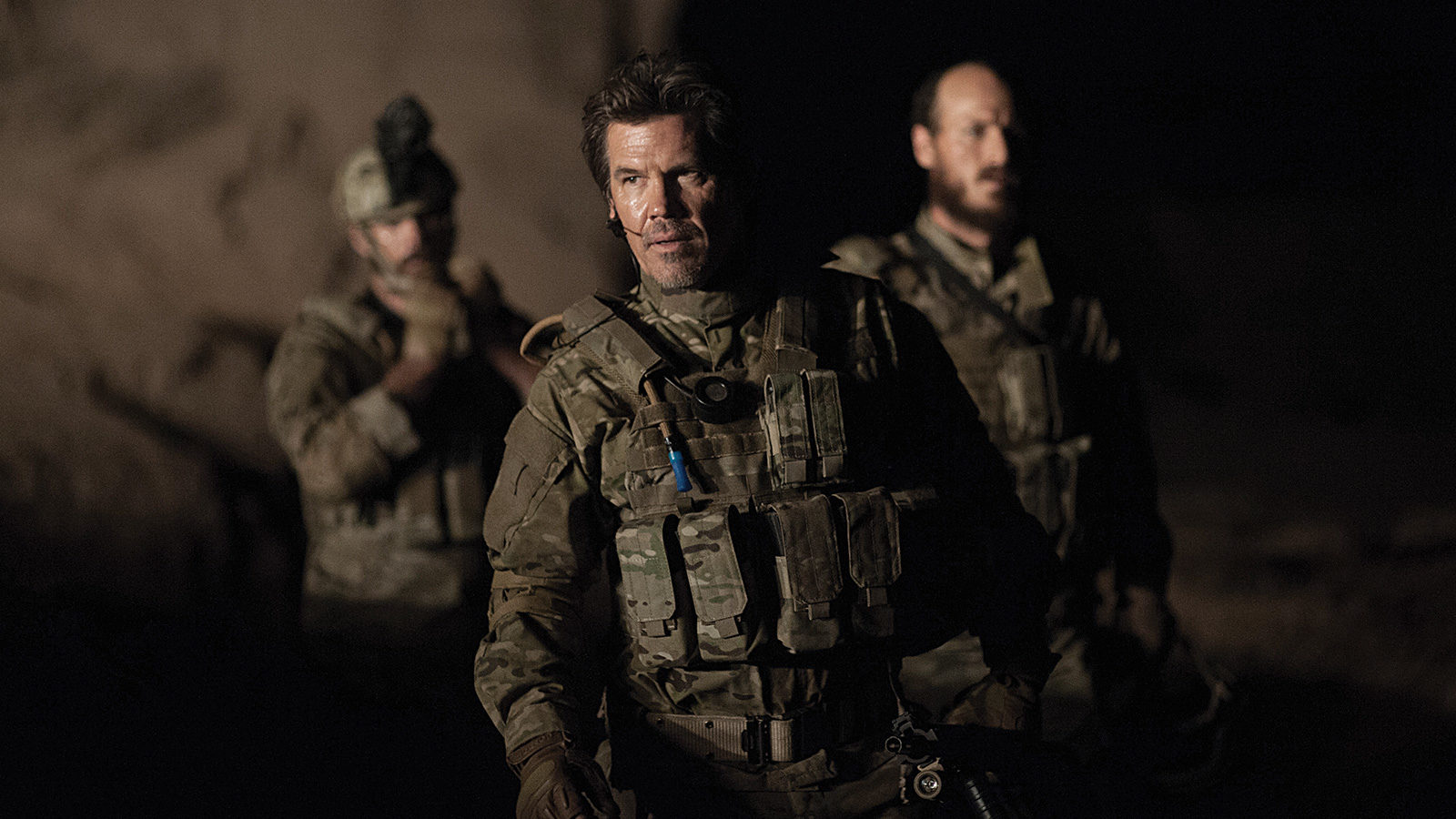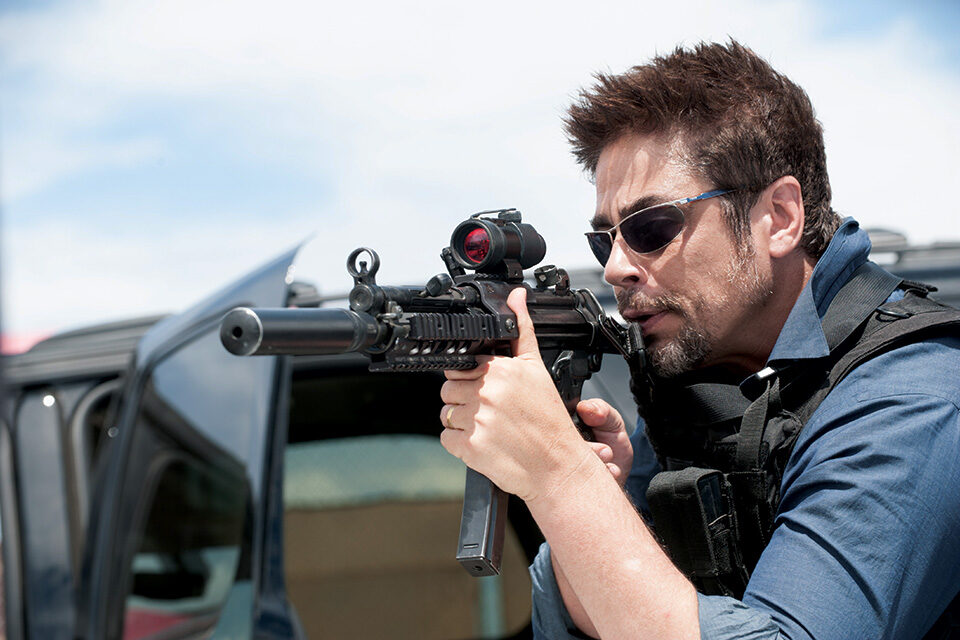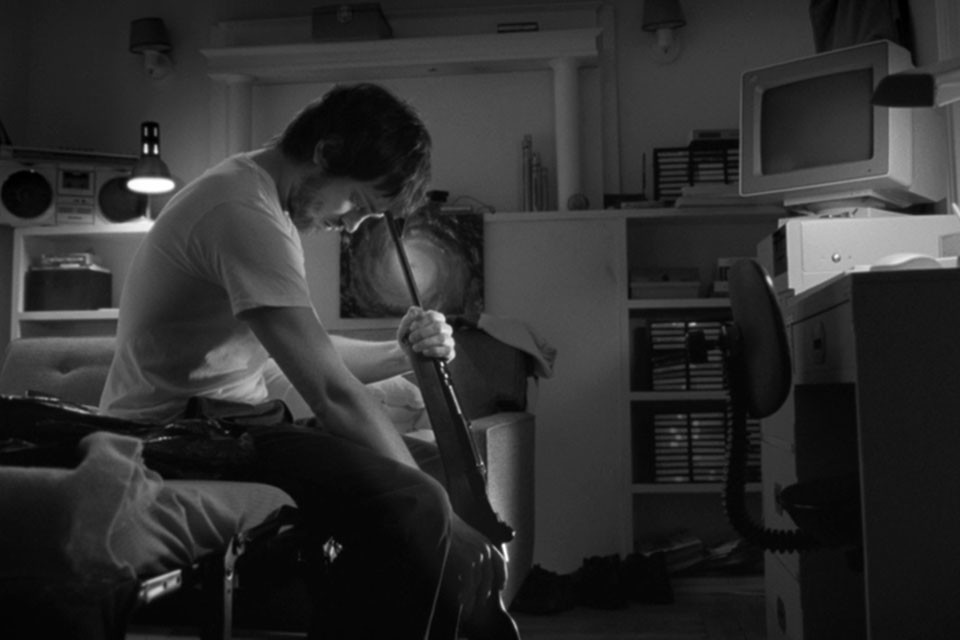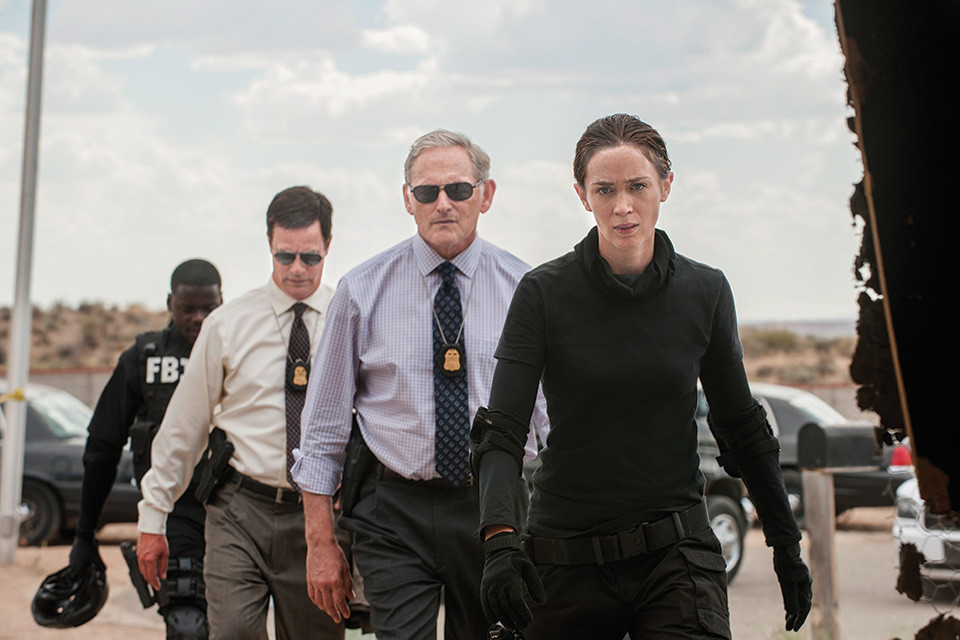
Controlling Chaos
Ciudad Juárez lies just across the rio grande from El Paso. It’s almost part of America, but it may as well be Fallujah. Or one of the circles of Hell. Juárez is infamous for its more than 1,000 unsolved murders of young women, but an early sequence in Sicario renders the city far more sweeping in its perils. Naked decapitated bodies dangle from a bridge, welcoming our unlucky heroine, FBI agent Kate Macer (Emily Blunt). A traffic jam erupts into a bloodbath with no discernible prompt. And while Mexicans still flock to Juárez because of its plentiful maquiladoras (factories in a free-trade zone), the only financial transactions that matter for Sicario’s purposes are those linking a handful of cartel titans to the millions of Americans with an appetite for narcotics.

Considered “a trooper” by her superiors, Kate is invited to join an elite interagency task force charged with locating a known narcotraficante. The team’s ostensible leader is callous Defense Department contractor Matt Graver (Josh Brolin), though he seems to take his cues from the mysterious Alejandro (Benicio Del Toro), a taciturn former attorney. Kate, a scrupulous idealist is shocked to discover that the team is operating outside U.S. jurisdiction, ignoring the rules of engagement, and illegally detaining and torturing prisoners. Sicario, the screenwriting debut of Sons of Anarchy actor Taylor Sheridan, isn’t above the odd hoary portent—“Nothing will make sense to your American ears,” someone warns—and betrays no qualms about exploiting age-old fears of Mexico, characterized here as one vast bogeynation, the toxic sewer of its affluent northern neighbor, pitiable but unsalvageable.
Preying on pervasive fear and paranoia is the business of horror movies, and, if we loosen our definition of the genre just a little, one could argue that horror movies are what Denis Villeneuve, the director of Sicario, has been making over the second phase of his career. It began with Polytechnique (09), a film rooted in real-life horror, and has continued through a series of projects that have taken Villeneuve far from his Quebec roots, to an eerily drab Toronto, a scorched Middle East, the suburbs of Pennsylvania, and now the murder capital of Mexico. (His 2013 Prisoners could have been the title of either of the above films.) “I go where I’m sent,” says one of Sicario’s mercenaries; the same statement of purpose could be applied to Villeneuve, a filmmaker who’s never met a location he didn’t find alluringly alienating. Never flattering any of these places, he seeks out the sinister everywhere. When the material is strong, his dark renderings become a mirror to the world.

Sicario
In Villeneuve’s debut feature, August 32nd on Earth (98), a woman survives an accident, cancels both a vacation and a modeling career, and goes to Utah to conceive a child. Pregnancy features in every one of his films with the exception of Prisoners, though August 32nd on Earth is the only one in which it is not a source of terror. Maelström (00) opens with an abortion being performed. The extracted pulp is disposed of with only slightly more ceremony than the film’s fanciful succession of talking fishes, each of whom are executed by a butcher’s blade while in the midst of narrating Villeneuve’s fable about a hit-and-run and the subsequent romance between the guilty driver and the victim’s son. Villeneuve’s stories have always been a matter of life and death, but their gravity and grimness would intensify by several degrees of magnitude with his third feature, which didn’t appear until a full nine years later.
I can’t think of a single event that’s occurred in Canada during my lifetime more freighted with trauma than the 1989 massacre at Montreal’s École Polytechnique, when Marc Lépine shot 28 people, killing 14 women, before turning the rifle on himself. His suicide note stated that he was motivated by a hatred of feminism, which he considered responsible for ruining his life. The note is quoted in Polytechnique, which frequently lingers on the visage of the Lépine character, played by Maxim Gaudette and identified simply as “Killer” in the credits. That visage, unsurprisingly, tells us nothing, having been neutralized by murderous resolve, just as Pierre Gill’s black-and-white cinematography neutralizes the film’s outpouring of blood.
If there is meaning amid the carnage of Polytechnique, it lays elsewhere, perhaps in the interspersion of reminders that Lépine’s sexism was not bred in isolation. When one student, Val (Karine Vanasse), applies for a mechanical-engineering internship, her male interviewer asks if she wouldn’t prefer civil engineering, a friendlier vocation for women who want to raise a family. (By the film’s denouement, Val, who barely escaped the campus slaughter, is working as a mechanical engineer and with child.) Everything seems gendered in Polytechnique, down to the names of bands on its soundtrack, Men Without Hats and Sisters of Mercy.
Perhaps meaning is best sought in Villeneuve’s mise en scène. In Gus Van Sant’s Elephant, another film based on a real-life school massacre, form is commentary, with Harris Savides’s cinematography emulating the video games played by the film’s murderers. Polytechnique’s camerawork isn’t so explicitly analytical, but its sideways pans and upside-down swoops through university corridors certainly anticipate the atmospherics that will characterize all of Villeneuve’s ensuing work.

Polytechnique
The plot of Incendies (10) could be reduced to one cruel twist of fate after another: a woman (Lubna Azabal) post-humously sends her adult children on a dangerous investigative mission to an unspecified Middle Eastern country through which they will finally learn the truth of her past and their origins—revelations worthy of classical tragedy. Adapted from Wajdi Mouawad’s 2003 play, Incendies roils with atrocities and its third act feels preposterous, yet it leaves an indelible impression, partly because Azabal, an actress of rare talents, exudes a survivor’s fortress-like self-possession, and partly because Villeneuve gives sentimentality no quarter. His rapturous opening sequence, apropos of nothing, story-wise, features child soldiers gearing up to the holy war battle hymn of “You and Whose Army?” by Radiohead. Anticipating the bifurcated geography of Sicario, Villeneuve photographs institutional buildings and freeways in Polytechnique’s Montreal and bombed-out cities and desert prisons on the other side of the planet in Incendies with the same emphasis on desolation.
Which brings us to Toronto and Enemy (13), an adaptation of José Saramago’s The Double, and yet Villeneuve’s most personal and perfect film. Canada’s largest city had never been depicted with so little color, affection, or interest in its cultural spectrum. Enemy concerns only three characters and two of them are played by Jake Gyllenhaal, whose singular gift for externalizing unease meets its ideal interpreter in Villeneuve. This smoggy, jaundiced town is not big enough for the two Jakes, yet its elevated roadways, brutalist buildings, and mirrored facades compose a sprawling opaque landscape ideal for Villeneuve’s fusion of primal anxiety and le fantastique.
Was Sicario made in repudiation of the politics of Prisoners? As risible twists accumulate, Prisoners slowly slips from riveting to ridiculous, but what’s most abhorrent about screenwriter Aaron Guzikowski’s conception is also what makes the film weirdly compelling. In agony over the apparent kidnapping of his daughter, Keller Dover (Hugh Jackman) abducts, imprisons, and tortures the prime suspect. Nothing in Villeneuve’s bleak realization of Guzikowski’s script feels at all pro-American, much less pro-Bush, yet our invitation to sympathize with Keller, both in the first early scenes and in its ersatz Vanishing finale, could suggest an apology for the use of torture and unlawful detainment in the war on terror.
By contrast, Sicario’s every moment unambiguously execrates the war on drugs, depicting clandestine U.S. interventions that only help perpetuate a billion-dollar industry at the expense of tens of thousands of Mexicans caught in the crossfire. The film begins with the discovery of over 40 cadavers, all of them bound, heads wrapped in plastic, and propped up within the walls of a bungalow like vertical graves. An entire SWAT team vomits in response. Figuratively speaking, the vomiting never stops for the remainder of Sicario, it’s only the source of nausea that shifts, from the immediate grisliness of bodily desecration to the meta-horrors of the gung-ho American agitation—“shake the tree and create chaos”—championed by Matt.

Sicario
If Matt is this film’s proponent of the preemptive impulse exemplified by Keller in Prisoners, Alejandro, whose wife and children were casualties of narco warfare, shares something of Keller’s psychic wound and supposed justifications. Alejandro is Sicario’s titular character—sicario being a Mexican synonym for hit man—and among the pivotal achievements in Villeneuve and Del Toro’s interpretation is the way they render Alejandro at once ghoulishly fascinating and, unlike Keller, not at all ingratiating or sympathetic in his appetite for ruthless revenge. Alejandro saves Kate’s life at one point, but she needn’t take this any more personally than the later scene in which he threatens to kill her. Alejandro is among the finest manifestations of Del Toro’s control of charisma and repugnance. It’s latent in his physiognomy, those heavy-lidded eyes that blur sexy and scary, but also in his craft, the distribution of weight in his carriage, the prolonged gazes and pauses that define evocative elision. He’s a heavy of a higher order—his Pablo Escobar in this year’s Escobar: Paradise Lost was the only redeeming factor in one of the stupidest movies I’ve ever seen.
Kate, meanwhile, isn’t exactly a cipher. Like Laura in Miss Bala, another narco-drama set along the Mexico-U.S. border, she’s more a female pawn in a boy’s-club conspiracy that renders criminals and authorities indistinguishable from one another, a heroine caught in a situation she can’t fully comprehend. And like Clarice in Silence of the Lambs, Kate is the female bait in a macabre stakeout, her descent into the underworld climaxing literally underground in a transnational tunnel, a lower intestine that shits out drugs and scumbags. There comes a point when Kate is able to flee, but she stays because she has to know the task force’s true objective. Yet in Sicario’s closed circuit of supply and demand, the truth is finally of no use at all.
Sicario mines the same dismal tit-for-tat trajectories as Prisoners but spares us the thudding ironies. Its moral strength lies in Sheridan and Villeneuve’s resistance to false resolutions and their insistence on maintaining a status quo of controlled chaos. Controlled, that is, for Americans, for whom the war on drugs is largely a cold war. For Mexico, where the war is corrosive and the body count defies belief, where huge swathes of the population live in perpetual fear, it’s just chaos.





